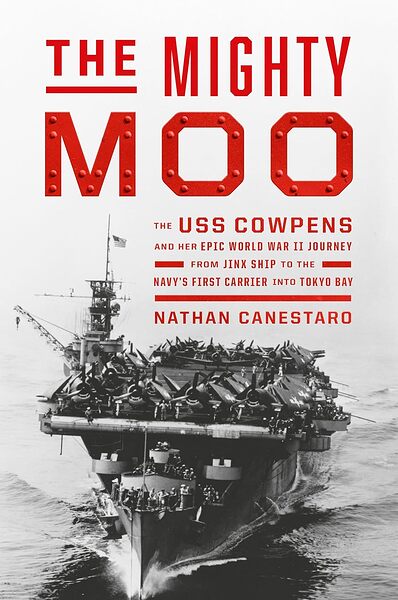Looking for a good read? Here is a recommendation. I have an unusual approach to reviewing books. I review books I feel merit a review. Each review is an opportunity to recommend a book. If I do not think a book is worth reading, I find another book to review. You do not have to agree with everything every author has written (I do not), but the fiction I review is entertaining (and often thought-provoking) and the non-fiction contain ideas worth reading.
Book Review
A Light Carrier’s War
Reviewed by Mark Lardas
January 19, 2025
“The Mighty Moo: The USS Cowpens and Her Epic World War II Journey from Jinx Ship to the Navy’s First Carrier into Tokyo Bay,” by Nathan Canestaro, Grand Central Publishing, 2024, 416 pages, $35.00 (Hardcover), $16.99 (Ebook), $24.50 (Audiobook)
USS Cowpens was one of nine light aircraft carriers in the United States Navy during World War II. Built on cruiser hulls, these ships were smaller than the fleet carriers the Navy preferred. Yet Cowpens and its sisters could be completed quickly, providing extra fast carriers quickly, before the larger Essex-class fleet carriers could enter service.
“The Mighty Moo: The USS Cowpens and Her Epic World War II Journey from Jinx Ship to the Navy’s First Carrier into Tokyo Bay,” by Nathan Canestaro, tells the story of Cowpens during World War II. It shows how a ship, initially unwanted by the US Navy, made a major contribution towards victory in the Pacific.
It was built because of an emergency. In 1942 the US Navy was losing fast carriers faster than they could be replaced. A pre-war proposal existed to convert Cleveland-class light cruisers into light aircraft carriers. It had been rejected because the resulting carriers would, at 14,000 tons, be too small to field a full air group. The upcoming 35,000 ton Essex class would do the job better. But carriers were needed quickly, so the Navy ordered nine light carriers, including Cowpens. All were delivered within 22 months. The first was commissioned in January 1943.
Canestaro, whose grandfather served aboard Cowpens, follows what happened. He shows how the Cowpens was completed, and entered service with a green crew. The captain and a few of the senior officers and petty officers were regular navy, but most of the crew were reserve officers, reservists, and wartime recruits.
Canestaro shows how they came together to form a team. Initially there were rocks and shoals, including a grounding incident. Yet by the time it reached the Pacific*, Cowpens* had coalesced into an effective unit. The crew even gave it the whimsical nickname “The Mighty Moo,” playing off the cow part of Cowpens. It participated in virtually every major Pacific campaign from the Wake Island strikes in October 1943 through the final carrier strikes on Japan in July 1945.
“The Mighty Moo” tells a Cinderella story. It shows how the ship and its crew rose from an unpromising start to become an integral part of the US Navy’s Fast Carrier Force. It may have played a supporting role, but its role was crucial regardless. More, it is an intensely personal story, one that shows the stresses men face in both warfare and at sea.
Mark Lardas, an engineer, freelance writer, historian, and model-maker, lives in League City. His website is marklardas.com.
